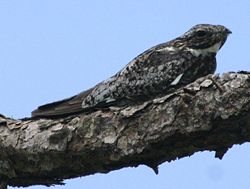| Nighthawk | |
|---|---|
 | |
| Common nighthawk, Chordeiles minor | |
| Scientific classification | |
| Kingdom: | Animalia |
| Phylum: | Chordata |
| Class: | Aves |
| Clade: | Strisores |
| Order: | Caprimulgiformes |
| Family: | Caprimulgidae |
| Subfamily: | Chordeilinae |
| Genera | |
Nighthawks are ten New World species of nightjar in the family Caprimulgidae.
The nightjar family Caprimulgidae has been traditionally divided into two subfamilies, Chordeilinae containing the nighthawks in four genera, and Caprimulginae containing all the remaining species. [1] The subfamily Chordeilinae had been introduced in 1851 by the American ornithologist John Cassin. [2] [3] The nighthawks were placed in four genera: Chordeiles Swainson, 1832 containing five species, Lurocalis Cassin, 1851 containing two species, Podager Wagler, 1832 containing the nacunda nighthawk, and Nyctiprogne Bonaparte, 1857 containing two species. The nighthawks have short bills and generally lack the elongated rictal bristles that are present in other nightjars. They also tend to be less nocturnal that other nightjars and can be observed feeding at dawn and at dusk. [1] Beginning in 2010 molecular phylogenetic studies have found that the nacunda nighthawk in the monotypic genus Podager was embedded with members of the genus Chordeiles and that the three remaining genera were not closely related to one another making the subfamily Chordeilinae non-monophyletic. [4] [5] [6]
| Image | Genus | Living species |
|---|---|---|
 | Nyctiprogne Bonaparte, 1857 |
|
 | Lurocalis Cassin, 1851 |
|
 | Chordeiles Swainson, 1832 |
|